Lobster
Nephropidae
Have been known to reach 100 years old!
Advertisement
Lobster Scientific Classification
- Kingdom
- Animalia
- Phylum
- Arthropoda
- Order
- Decapoda
- Family
- Nephropidae
- Scientific Name
- Nephropidae
Read our Complete Guide to Classification of Animals.
Lobster Conservation Status
Lobster Facts
- Main Prey
- Clams, Mussels, Starfish
- Habitat
- Sea gardens and rocky beds
- Predators
- Human, Eels, Large fish
- Diet
- Carnivore
- Average Litter Size
- 12
View all of the Lobster images!
Could lobsters hold the key to eternal life?
Lobsters are a family of crustaceans that live in waters along most of the world’s coastlines. There are 30 known species of clawed lobsters and 45 species of spiny (or rock) lobsters.
The largest lobster species is the American lobster, which can be found from the coasts of North Carolina into Newfoundland. Because American lobsters grow continuously throughout their lives, they can reach sizes larger than any other living crustacean.
Lobsters are animals that are closely related to insects because they have an exoskeleton and jointed legs like a spider. They’re omnivores, eating both fish and algae. Lobsters have poor eyesight, so they depend on their ability to taste and smell while moving across the bottom of the ocean.
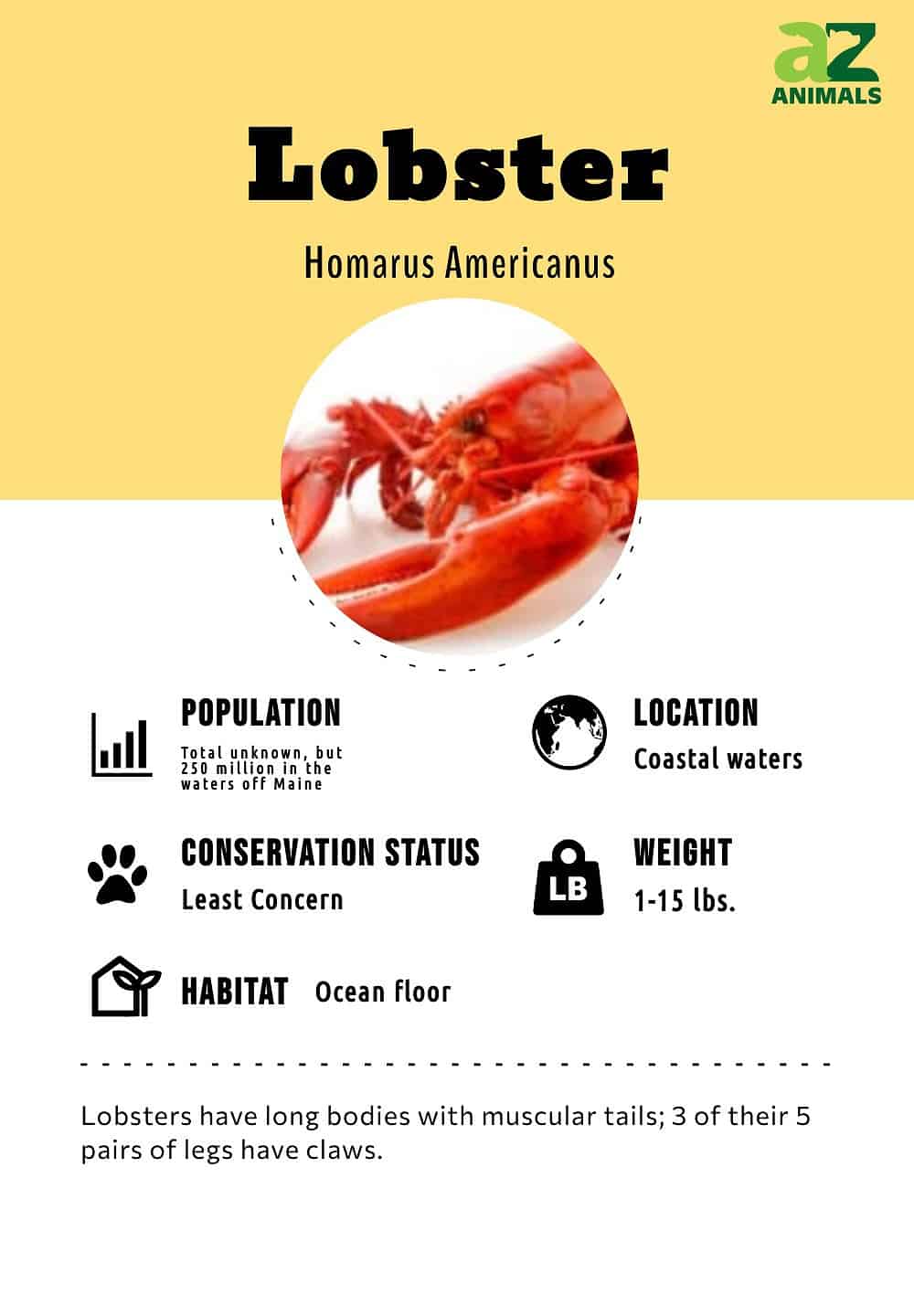
5 Incredible Facts
- With a brain in their throat and teeth in their stomach, lobsters have some of the most unusual anatomy across the animal kingdom. Their eyes detect shadows and light, but not colors or images. Their stomach contains their “teeth,” a gastric mill that crushes up food. A lobster’s brain is located in its throat and is about the size of a grasshopper’s. Their heart and central nervous system lays in their abdomen. In addition, lobsters “taste” with their feet and “hear” using a series of sensory hairs on their legs!
- A lobster underbelly is as strong as car tires! The underbelly membrane of lobsters (which protects against rocks on the seafloor) is about as strong as industrial rubber!
- The largest lobster ever recorded might have been 100 years old! The largest lobster ever recorded was caught off Nova Scotia in 1977 and weighed 44 pounds 6 ounces, according to the Guinness Book of World Records. While age estimates of lobsters are inaccurate, it is believed this lobster may have been 100 years old. Learn about the longest living animals here.
- Lobsters used to be considered “cockroaches of the sea.” In the early 1800s lobsters were so plentiful in New England that they occasionally would wash ashore in piles two feet high! While lobsters today are seen as “gourmet” food, they were so plentiful in early America that Massachusetts servants demanded they be served a maximum of only three dinners per week!
- The key to eternal life? Unlike most animals that stop growing once their adult stage is reached, lobsters grow continuously throughout their lives. Does this mean lobsters could hold the key to “immortal life?” To read more, scroll down to our “could lobsters live forever?” section!
Scientific Name
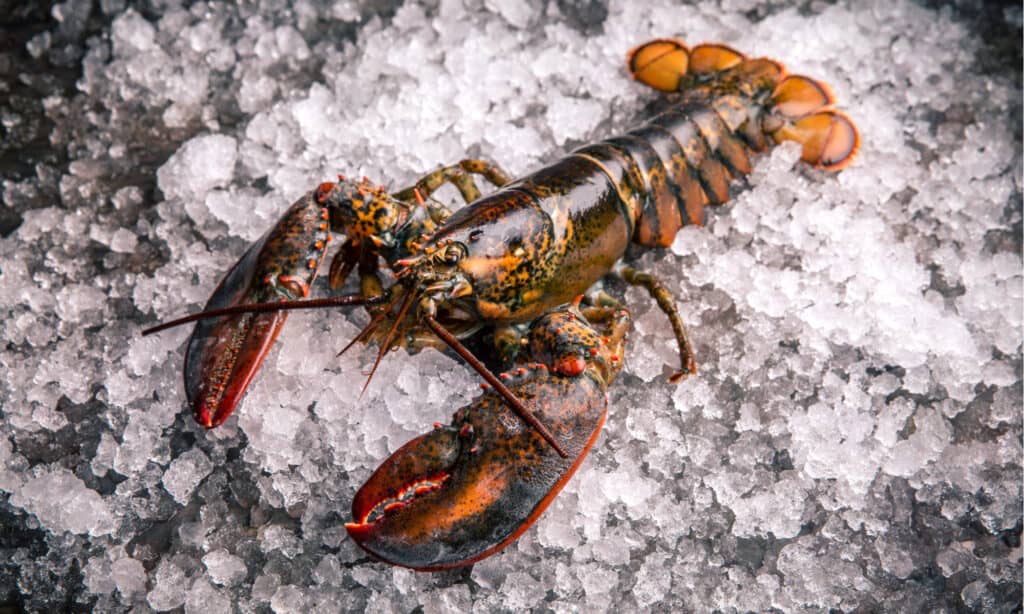
The lobster has a long evolutionary history as a decapod and crustacean.
©MaryLucky/Shutterstock.com
In regards to the type of lobster most Americans know, its common name is the American or Maine lobster. Its scientific name is Homarus Americanus. Other commonly used names include the Atlantic lobster as well as the true lobster.
Scientists think that decapods, like the mole crab (Emerita), evolved 450 million years, lobster-like crustaceans about 360 million years ago, and the ancestor of what we know today as the lobster showed up about 12 million years ago. Lobsters and crabs, then, share an evolutionary history.
The taxonomy of the lobster shows that it belongs to the Nephropidae family and is in the class Crustacea, order Decapoda. The Greek word Decapoda deka meaning ten and pous meaning feet.
Other crustaceans, like spiny lobsters (Palinuridae) and slipper lobsters, may be called “lobster,” but they are not closely related and have no large claws like the very large front claws of the Maine lobster. The same is true for the squat lobster.
The relatives that are most similar are the reef lobsters and three families of freshwater crayfish. So, the term “lobster” best refers to the American or Maine lobster, which is why some call it the true lobster.
Among edible lobsters, the Norway lobster (Nephrops norvegicus), is commercially popular in Europe, but it grows to only about 10 inches long. The average American lobster is twice that size.
Appearance and Behavior

A Blue Lobster is very rare, only one in every two million lobsters!
©Steven G. Johnson / Creative Commons – Original
When you think of a lobster, you may picture a red lobster sitting on someone’s dinner plate. However, they don’t turn red until after they’re cooked. The American or Maine lobster is greenish brown in color. Lobsters can be found in different colors, but these variations are extremely rare. The Maine Fisherman’s Alliance estimates that:
- Every one in two million lobsters is blue
- Looking for a yellow lobster? They’re seen once every 30 million lobsters.
- White lobsters are even rarer! The chance of seeing a white lobster is about one in 100 million!
The brownish color of most lobsters allows them to blend in with the sand and rocks on the bottom of the ocean. This can keep them hidden from predators. If a lobster spots a predator, it will scoot backward using its tail fin to move into a rock crevice. The fastest speed on record for a lobster moving backward is 11 mph.
A lobster’s body has two main parts covered in a hard shell. It can grow to be a little more than three feet long, but the average is 8-24 inches. Lobsters vary in weight from 1 pound to 15 pounds. Of course, there are lobsters that weigh more than 15 pounds.
The American lobster has two claws, antennae, and two tiny black eyes. Its eyes don’t play a big part in its nocturnal hunting activities. The small sensory hairs on its ten legs and feet help a lobster to identify its prey. Also, a lobster uses its antennae to smell prey even if it’s far away.
Lobsters are solitary and shy animals most of the time. However, they become aggressive when defending their territory against other lobsters. One lobster may push another with its claws in an effort to move it out of the territory.
Habitat
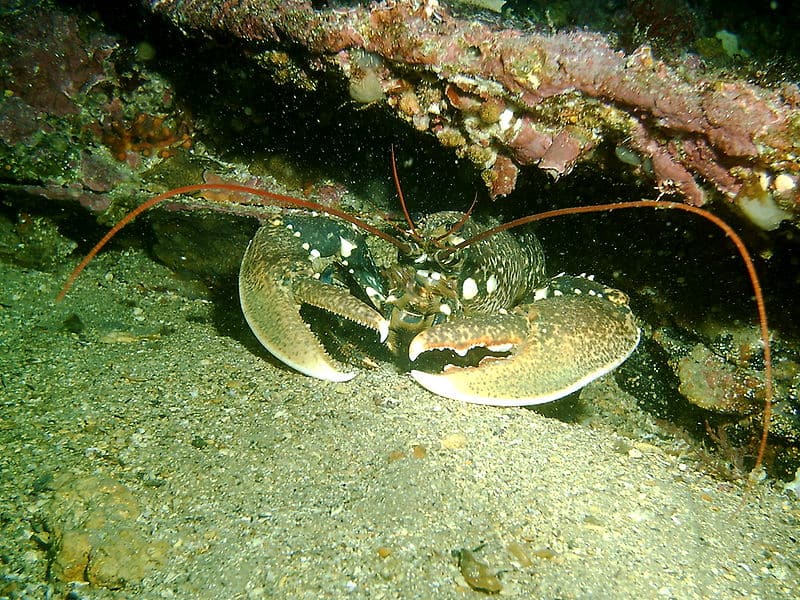
A lobster in its habitat on the ocean floor hiding between rocks.
©Pedrosanch / Creative Commons – Original
American lobsters live in the northern Atlantic Ocean. They prefer cold water habitats and live on the floor of the ocean hiding between rocks and digging in the sand. Different lobster subspecies, such as the Spiny lobster, live in warm, tropical waters like the Gulf of Mexico, the Caribbean Sea and off the coast of Florida in the Atlantic Ocean.
The tiny eyes of a lobster have thousands of lenses. Their eyes are sensitive to bright light, so it’s a good thing they live at the bottom of the ocean! Although they can’t see clearly, lobsters can see shadows and dim images, which helps them avoid predators moving into the area.
These crustaceans use both of their claws to dig into the sand near a rock to make itself a home. This home can serve as protection against predators.
Scientists have found that American lobsters migrate away from the shoreline in the winter and spring. They want to live in the warmer, deep water during the cold weather months. As the weather warms up in the summer and stays warm into early fall, they move back toward the shore. Some lobsters move up and down the shoreline, never staying in one place.
Diet
What do lobsters eat? Lobsters are omnivores. They eat mussels, sand fleas, clams, shrimp, and sometimes tiny fish. They are slow-moving, so they usually hunt slow-moving prey. They grab hold of their prey with their strong claws and squeeze. If they can’t find any of these animals to eat, lobsters eat plants that grow underwater.
Predators and Threats
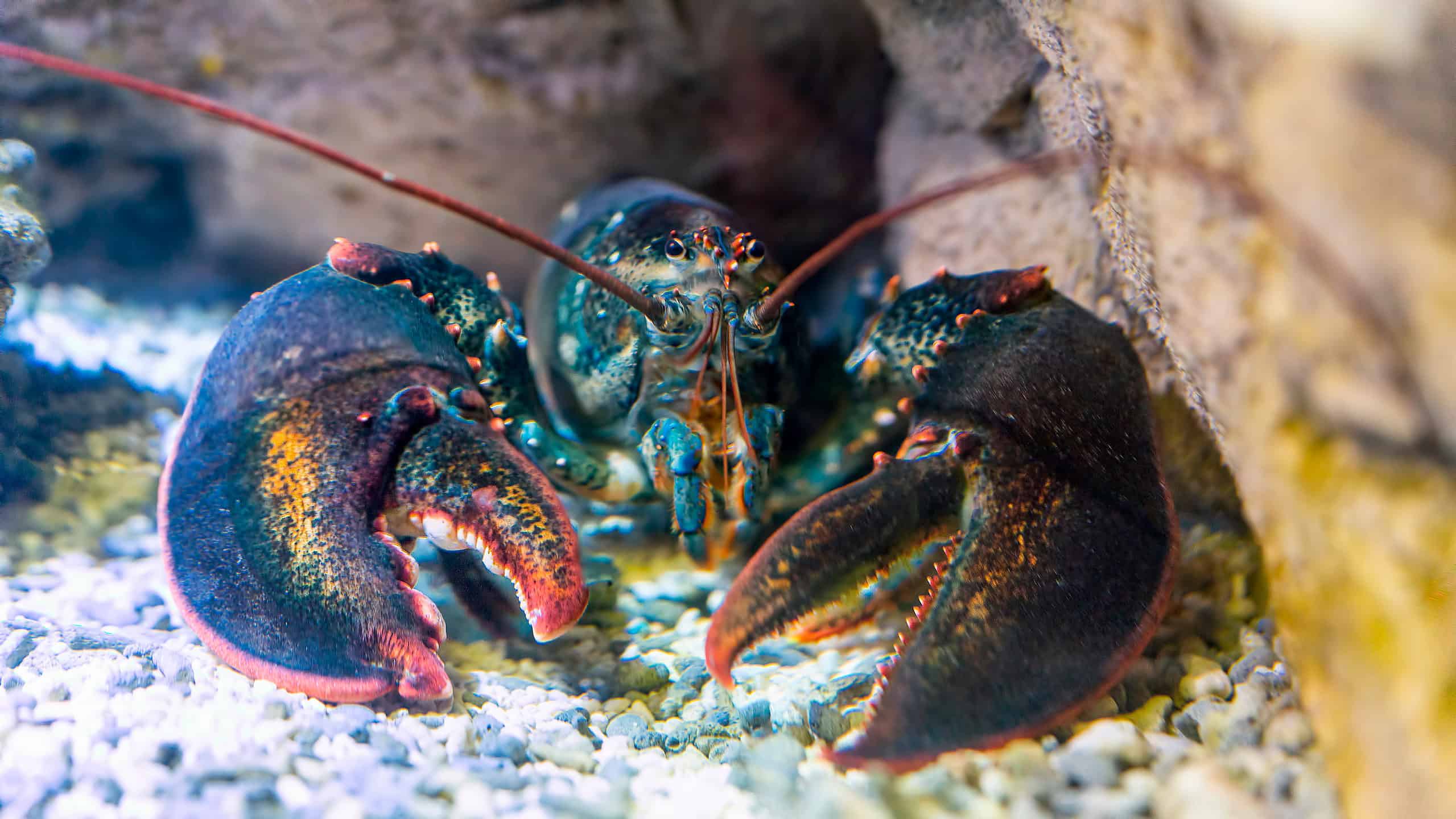
Most Maine lobsters are green to blend in near rocks, which hides them from predators.
©OSDG/Shutterstock.com
Lobsters have many predators, including eels, crabs, seals and rock gunnels. An eel is able to push its thin body into rock crevices to grab a lobster that’s hiding there. Seals are fast swimmers and can catch lobsters with their powerful jaws. In addition, some fish such as flounder and cod also eat lobsters. However, the biggest threat to lobsters is humans. Millions of lobsters are caught in nets to sell in seafood markets and restaurants. People eat the heavily muscled abdomen and claws of the American lobster, but only the abdomen (marketed as a lobster tail) of the spiny lobster.
When it comes to disease, lobsters can suffer from shell disease as well as different types of fungus and parasites. They are also threatened by chemicals and other pollutants in the ocean waters. The official conservation status of lobsters is Least Concern.
Reproduction, Babies and Lifespan
Lobster mating involves a dominant male that typically mates with a group of females. A unique aspect of lobster mating is that females must shed their hard-outer shell before mating, which leaves them at risk of predation. During this period females will live inside caves inhabited by males, who offer protection. After approximately two weeks’ time, the females shell will have regrown and she can leave. At this point, a new female will join the male.
A female lobster carries sperm from a male so she can fertilize her eggs in July or August. She carries her eggs on the underside of her abdomen for about ten months. The typical lobster carries 8,000 eggs at a time. However, some female lobsters can carry as many as 100,000 eggs! After ten months, the female releases the lobster larvae, also known as hatchlings, into the ocean waters. A female lobster breeds every two years.
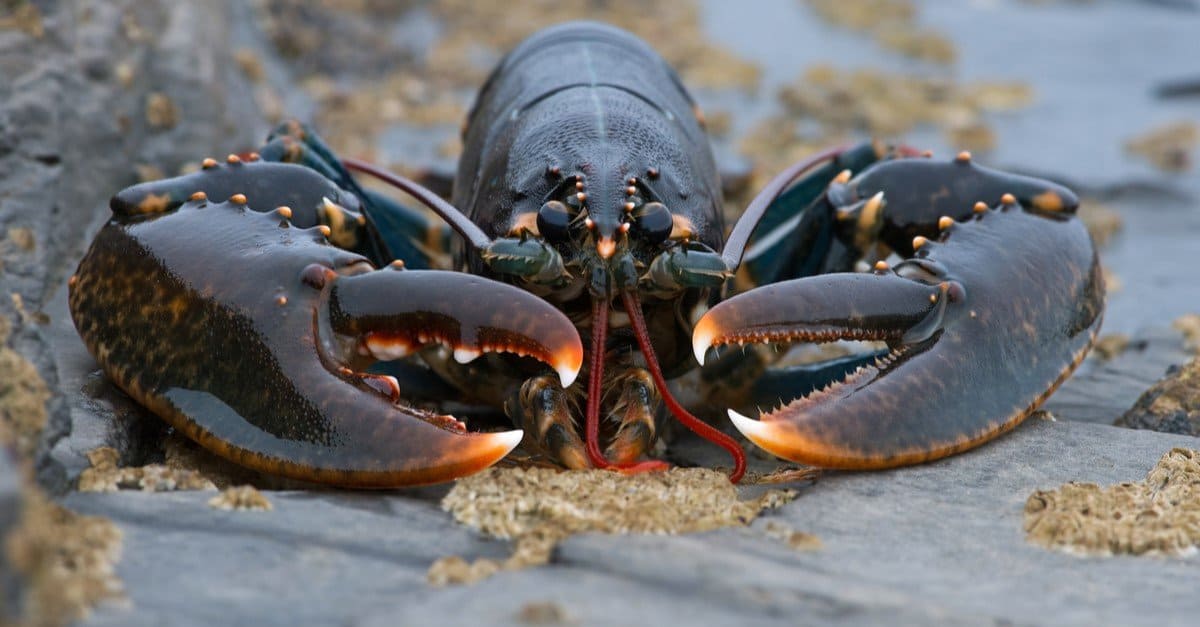
Some species of lobster can be quite large and can live 50 years or more!
©davemhuntphotography/Shutterstock.com
For four to six weeks, the larvae floats on or near the surface and eats plankton. During these weeks, the larvae molts (sheds their shells) four times, growing a new one each time. After shedding its fourth shell, the larvae is large enough to sink down to the ocean floor.
Not surprisingly, it’s estimated that only about ten percent of the lobster larvae grow big enough to sink into the ocean. These tiny larvae are eaten by fish, seals, sea gulls and other animals before they’re large enough to sink. Just imagine a seal swimming by and eating hundreds or even thousands of these little larvae at one time. Ten percent of 8,000 is 800 larvae that make it, though.
Once a young lobster does descend to the ocean floor, it makes its home by digging in the sand beneath a rock. At this point, the young lobster is about one pound.
Lobsters can live to be 50 years old or older. As they age, they can suffer from shell rot and various types of parasites. The oldest lobster in the world was caught in 2009. Scientists believe it’s 140 years old.
Lobsters have the ability to regrow legs, claws, and antennae if they fall off due to injury or disease. In fact, scientists believe that losing a claw or leg is not a painful experience for a lobster. It can be lifesaving and prevent infection to the crustacean. This regrowth makes it a little easier to see how a lobster can live such a long life in the ocean!
Population
The population of American lobsters in the Gulf of Maine is approximately 250 million. Although millions of lobsters are caught each year by fishermen, the population is holding steady. The total population of spiny lobsters and others that live in tropical waters is not known. The official conservation status of American lobsters is Least Concern.
As a note, if a fisherman catches a female lobster who is carrying eggs on her abdomen, it’s against the law to keep her. The fisherman must put her back in the water. This is one of the efforts being made to make sure the lobster population steadily grows.
More
View all 98 animals that start with LLobster FAQs (Frequently Asked Questions)
Are lobsters bugs?
No, not exactly. Sometimes lobsters are called bugs because they share a few characteristics with them. For one, both lobsters and bugs like grasshoppers have an exoskeleton (a hard shell). Also, lobsters and many bugs like crickets have jointed legs. A jointed leg has a few places where it can bend. In short, there are a lot of similarities between bugs and lobsters.
Are lobsters carnivores, herbivores or omnivores?
Lobsters are omnivores. They hunt sea creatures including mussels, clams, shrimp and sand fleas. But, if a lobster can’t find any of those animals, it will eat seaweed and other undersea plants. The larger of a lobster’s claws is called its crusher claw. It is the larger of the two claws. It’s used to crush the shells of clams, oysters and similar lobster prey.
Are lobsters aggressive?
Normally, lobsters are shy, harmless sea creatures. But, a lobster will become aggressive if its territory is invaded by another lobster. It will use its claws and body to push the intruder out of the area. Also, male lobsters can be aggressive during breeding season when competing for females.
Do lobsters eat one another?
Some people believe that lobsters eat one another. This is known as cannibalism. But, this is not a proven fact. Lobsters have been observed to attack one another when they are packed together in a small tank. But, in the wild, lobsters aren’t known to have this behavior.
Could lobsters live forever?
You may have seen headlines for lobsters claiming they hold the key to eternal life and could even contain a state called “biological immortality.” So, what’s the real story behind lobsters and living forever?
The idea that lobsters could conceptually live forever comes from their production of an enzyme named telomerase. In most vertebrates (like humans) telomerase is only produced in early stages of life and aids in growth. However, lobsters appear to produce telomerase throughout their lives, which means they continue to grow larger and even regenerate limbs at advanced ages like 100.
However, even with this fascinating biological quirk, lobsters will die as they age. The reason is that as lobsters get older the energy required to shed their shell (molt) becomes too great and they cease shedding their exoskeleton. Once lobsters stop molting, bacteria begin infecting their shells, and eventually leads to lobsters perishing whether by shell rot, or scar tissues that conjoin their bodies to their shells.
The bottom line: while lobsters have an interesting biological quirk that allows them to continue growing throughout their lives, they will perish from old age as they’re unable to molt any longer.
What Kingdom do Lobsters belong to?
Lobsters belong to the Kingdom Animalia.
What phylum do Lobsters belong to?
Lobsters belong to the phylum Arthropoda.
What family do Lobsters belong to?
Lobsters belong to the family Nephropidae.
What order do Lobsters belong to?
Lobsters belong to the order Decapoda.
What type of covering do Lobsters have?
Lobsters are covered in Shells.
In what type of habitat do Lobsters live?
Lobsters live in sea gardens and rocky beds.
What is the main prey for Lobsters?
Lobsters prey on clams, mussels, and starfish.
What are some predators of Lobsters?
Predators of Lobsters include humans, eels, and large fish.
What is the average litter size for a Lobster?
The average litter size for a Lobster is 12.
What is an interesting fact about Lobsters?
Lobsters have been known to reach 100 years old!
What is the scientific name for the Lobster?
The scientific name for the Lobster is Nephropidae.
What is the lifespan of a Lobster?
Lobsters can live for 20 to 80 years.
How do lobsters communicate?
Lobsters communicate with each other by urinating on each others’ faces from bladders located near their head.
How fast is a Lobster?
A Lobster can travel at speeds of up to 12 miles per hour.
How do Lobsters have babies?
Lobsters lay eggs.
What are the differences between langoustines and lobsters?
The key differences between langoustines and lobsters are appearance, lifespan, diet, and intelligence.
What are the differences between Canadian lobsters and Maine lobsters?
The major differences between Canadian and Maine lobsters are appearance, habitat, range, prey, and relationships with humans.
When comparing the Canadian and Maine lobsters, it is easy to see the traits they share and the ones they don’t. These crustaceans have similar colorings, lifespans, and hunting habits. They are both cold-water lobsters and have more in common than warm-water lobsters.
Let’s delve into their distinctions.
What are the key differences between spiny lobsters and Maine lobsters?
The key differences between spiny lobsters and Maine lobsters are appearance, size, habitat, taste, and lifespan.
What are the key differences between rock lobsters and Maine lobsters?
The key differences between rock lobsters and Maine lobsters are appearance, size, habitat, and lifespan.
What are the key differences between warm water and cold water lobsters?
The primary difference between cold water and warm water lobsters is that they prefer different sea temperatures. You can read about all of their differences here!
Thank you for reading! Have some feedback for us? Contact the AZ Animals editorial team.
Sources
- David Burnie, Dorling Kindersley (2011) Animal, The Definitive Visual Guide To The World's Wildlife / Accessed December 14, 2008
- Tom Jackson, Lorenz Books (2007) The World Encyclopedia Of Animals / Accessed December 14, 2008
- David Burnie, Kingfisher (2011) The Kingfisher Animal Encyclopedia / Accessed December 14, 2008
- Richard Mackay, University of California Press (2009) The Atlas Of Endangered Species / Accessed December 14, 2008
- David Burnie, Dorling Kindersley (2008) Illustrated Encyclopedia Of Animals / Accessed December 14, 2008
- Dorling Kindersley (2006) Dorling Kindersley Encyclopedia Of Animals / Accessed December 14, 2008


















